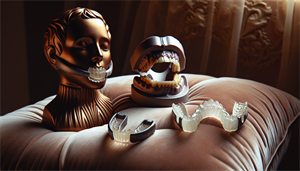What is a snore guard? It’s a device designed to reduce snoring by keeping your airway open at night. In this article, we’ll explore the functioning of snore guards, the available options, and their practical impact on sleep for both snorers and their partners.
Key Takeaways
-
Snore guards are dental devices that address ‘mouth snoring’ by maintaining an open airway during sleep through shifting the lower jaw forward and preventing the tongue from blocking the airway, thus reducing or eliminating snoring.
-
Various types of snore guards exist, including mandibular advancement devices (MADs), tongue-retaining devices (TRDs), custom-fitted, and boil-and-bite models, each offering different features to accommodate specific needs and preferences.
-
Snore guards can help with obstructive sleep apnea (OSA) by keeping the airway open, serving as an alternative to CPAP machines for some individuals. Professional consultation is recommended to diagnose snoring-related sleep disorders and to ensure proper fit, effectiveness, and maintenance of the device.
Understanding Snore Guards: Definition and Purpose

Snore guards, dental devices designed for snoring and teeth grinding, function by maintaining an open airway during sleep. They typically consist of two interconnected plastic trays tailored to suit the user’s mouth. They operate by:
-
gently shifting the lower jaw forward
-
preventing the tongue from falling back into the throat and obstructing the airway
-
ultimately reducing or even eliminating snoring.
Specifically, they inhibit the vibration of the throat and soft tissue muscles when air passes through them, a common cause of snoring sounds, thus addressing ‘mouth snoring’.
Snore Guard Basics
By gently advancing the lower jaw, snore guards enhance airflow through the upper airway and throat, thereby assisting in preventing snoring. They are composed of two polycarbonate thermoplastics that have been fused together, designed to comfortably fit over the upper and lower teeth.
There are various designs of snore guards aimed at preventing snoring. An example of this is an anti-snoring brace, which is a bow-shaped device covered in silicone. This type of product is designed to help reduce snoring during sleep. Placed at the back of the mouth, it applies gentle pressure to the palatal arch, helping to reduce mouth snoring.
The Purpose of a Snore Guard
A snore guard serves to:
-
Reduce snoring
-
Improve sleep quality for the user and their partner
-
Prevent the collapse and obstruction of the throat’s soft tissues
-
Maintain an open airway during sleep
-
Lead to a more restful and uninterrupted sleep experience
-
Reduce snoring sounds
Snore guards, a type of anti snoring device, are an effective way to stop snoring, prevent snoring, and eliminate snoring, improving sleep quality.
Not only can snore guards improve the sleep quality of the user, but they can also positively affect the sleep quality of bed partners of individuals who snore by mitigating snoring sounds and promoting a quieter sleep environment. When properly fitted and consistently utilized, the Snore Guard can be a suitable option for individuals dealing with snoring or obstructive sleep apnea (OSA). However, it is important to note that snore guards are not designed to treat central sleep apnea.
Types of Snore Guards: Finding the Right Fit for You

There are various types of snore guards, each tailored to accommodate different needs and preferences. Some common types include:
-
Mandibular advancement devices (MADs): These devices shift the lower jaw forward to keep the airway open.
-
Tongue-retaining devices (TRDs): These devices hold the tongue in place to prevent it from blocking the airway.
-
Custom-fitted snore guards: These are made specifically for your mouth and provide a comfortable fit.
-
Boil-and-bite snore guards: These can be molded to fit your mouth by boiling them and then biting down on them.
Consider your specific needs and preferences when choosing a snore guard. It may be helpful to consult with a healthcare professional to determine the best option for you.
Understanding the unique features of each type can help you find the right snore guard for you.
Mandibular Advancement Devices (MADs)
MADs, a common type of snoring mouthpiece, function by subtly moving the lower jaw forward to keep the airway open and reduce snoring during sleep, which can be caused by mouth breathing. They achieve this through a built-in connection, typically a tight-screw or plug connection, which applies slight tension to the lower jaw muscles.
MADs have demonstrated high effectiveness in reducing snoring and are adaptable to various sleeping positions. However, potential drawbacks of utilizing MADs include jaw pain and stiffness, drooling, and other adverse side effects. For some people, like those with braces or dentures, using them may not be possible. Usually, a prescription is needed for this.
Tongue-Retaining Devices (TRDs)
TRDs function by holding the tongue’s position to prevent it from falling into the back of the throat during sleep, a common cause of snoring, especially in back sleepers. They are recognized for their lightweight and comfortable design in comparison to MADs. They are generally less linked to negative effects, do not disrupt dentures or braces, and many do not necessitate a prescription.
However, the primary limitations of TRDs involve their ‘one-size-fits-all’ design, which may not be suitable for all users, and the potential to impede breathing by forming a seal around the mouth.
Custom-Fitted vs. Boil-and-Bite
Custom-fitted snore guards, dental devices customized to match the patient’s dentition and bite, provide increased comfort and effectiveness. On the other hand, boil-and-bite snore guards are a cost-effective solution that can be self-fitted at home. They are softened in hot water and then shaped to the user’s teeth by biting into them.
While custom-fitted snore guards provide a precise, tailored fit that enhances comfort and effectiveness, boil-and-bite snore guards offer a cost-effective and convenient alternative, although they may not fit as precisely.
How Snore Guards Help with Sleep Apnea

By keeping the airway open, snore guards can help with obstructive sleep apnea (OSA), offering a possible alternative to CPAP machines for some individuals. This is particularly important because, while CPAP machines are widely utilized as the primary treatment for sleep apnea, they may not be suitable for everyone due to discomfort or other issues.
Obstructive Sleep Apnea (OSA)
OSA, a sleep disorder, is marked by temporary pauses in breathing during sleep, usually accompanied by loud snoring due to airway obstruction. This can be primarily attributed to the relaxation of the muscles in the posterior throat. Key symptoms encompass:
-
heightened daytime drowsiness
-
prominent snoring
-
dry mouth or throat discomfort upon awakening
-
morning headaches
-
difficulties with breathing during sleep
It’s diagnosed through the use of sleep studies, such as polysomnography, which can be performed either in a sleep laboratory or at home.
If OSA is not addressed, it can result in various health risks such as:
-
Excess weight
-
Hypertension
-
Obesity
-
Diabetes
-
Daytime fatigue
-
High blood pressure
-
Heart disease
-
Heart failure
-
Stroke
-
Type 2 diabetes
-
Weight gain
-
Metabolic syndrome
-
Adult asthma
-
Potential brain damage
-
Depression
Snore Guards as an Alternative to CPAP
The snore guard, also referred to as a mandibular advancement device (MAD), has demonstrated the following benefits for severe obstructive sleep apnea (OSA) patients, as well as those with moderate sleep apnea:
-
Comparable effectiveness to CPAP machines in mitigating the risk of fatal cardiovascular events
-
Enhancing daytime alertness
-
Diminishing snoring
-
Alleviating OSA symptoms
Snore guards provide a more comfortable and less invasive treatment option for OSA by repositioning the lower jaw and maintaining an open airway, potentially leading to improved blood oxygen levels, decreased snoring, and relief from sleep apnea symptoms. However, they are not without potential side effects, which may include drooling and temporomandibular disturbances.
Proper Use and Care of Your Snore Guard

For optimal results and longevity, it’s crucial to use and maintain your snore guard appropriately. This involves appropriately fitting and adjusting the snore guard and regularly cleaning it to prevent discoloration, foul smells, and plaque buildup.
Good oral hygiene also plays a key role in achieving the best possible outcomes for dental implants and preserving overall oral health.
Fitting and Adjusting Your Snore Guard
Correct fitting and adjustment of your snore guard are essential for its effective functioning. The right fit should result in a snug and secure placement, with a noticeable pop into place. For instance, for mandibular advancement devices (MADs), you would need to turn each screw clockwise to bring the lower jaw forward and increase the airway opening, securing a tighter fit and ensuring the snore guard stays in place throughout the night. Adjust the device until it feels comfortable and secure to your liking.
For a tongue-retaining device (TRD), achieving a proper fit is crucial to ensure both comfort and effectiveness. If the device is excessively tight, it may lead to discomfort and reduced compliance. Therefore, ensuring a correct fit is essential for enhancing the device’s comfort and effectiveness.
Cleaning and Maintenance
Frequent cleaning and maintenance of your snore guard help extend its lifespan and retain its effectiveness. It is recommended to rinse the snore guard with warm water after each use, ensuring it is completely dried before storing it in the provided case. It is recommended to use a toothbrush and toothpaste for regular cleaning of the snore guard to maintain its cleanliness and effectiveness for a longer period of time. This will help remove any debris and bacteria that may have accumulated on the device..
In addition to standard cleaning, special gels, dedicated cleaning brushes, and dissolving tablets designed for snore guards can also be utilized to ensure thorough maintenance.
Consult a Professional: When to See a Dentist or Sleep Specialist

Should you experience any of the following symptoms, it’s advisable to seek professional help:
-
Loud, disruptive snoring
-
Excessive daytime sleepiness
-
Morning headaches
-
Gasping for breath during sleep
These symptoms may indicate a snoring disorder like sleep apnea, which necessitates a professional assessment of the snoring sound.
Assessing Your Snoring Situation
Through a physical examination and inquiries about your snoring patterns, a professional can assess your snoring situation. If a sleep disorder such as sleep apnea is suspected, additional tests or a sleep study may be recommended. Sleep studies such as polysomnography are used to diagnose sleep disorders related to snoring.
Dentists can also offer valuable insights when evaluating your snoring situation. They can select the most suitable snore guard and also identify indicators of sleep apnea, and if necessary, refer patients to medical treatments.
Ongoing Care and Monitoring
Frequent check-ups with a professional can ensure the continued effectiveness of your snore guard and address potential issues. During these check-ups, professionals can evaluate the reduction in snoring time and improvement in snoring symptoms reported by patients. They also examine the fit of the snore guard and may make adjustments if required.
Indicators that necessitate adjustment or replacement of a snore guard include:
-
The presence of small tears, cracks, or holes in the guard
-
An escalation in symptoms such as jaw pain or headaches
-
Diminished effectiveness in providing snore protection
It’s important to regularly consult with a professional to ensure your snore guard remains effective.
Summary
To sum up, snore guards are an effective solution to combat snoring, with different types and designs available to suit various needs. While they can help address obstructive sleep apnea, they should not be used as a replacement for professional medical advice or treatment. Proper use, fitting, and maintenance of your snore guard are essential for optimal results. Regular check-ups with a professional can ensure your snore guard remains effective and address any issues that may arise. So, are you ready to take a step towards a more restful night’s sleep?
Frequently Asked Questions
How does a snore guard work?
A snore guard works by using elastic strips or plastic spacers to bring the jaw forward and prevent the tongue from slipping towards the back of the throat, effectively reducing snoring.
What is the difference between a night guard and a snore guard?
The main difference is that snore guards help prevent snoring by repositioning the lower jaw and tongue, while night guards help prevent teeth grinding. Night guards have a simpler design compared to snore guards, which have a more complex structure to address snoring.
Do sleep guards work for snoring?
Yes, sleep guards work for snoring by repositioning the jaw and tongue to open the airway and reduce the vibration that causes snoring. This was found effective in 72% of patients according to a study published in Sleep and Breathing.
What are the side effects of snore guards?
Some reported side effects of snore guards include minor discomfort and excessive saliva production.


